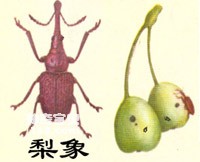Both adults and larvae of this species damage the fruits of pear trees, causing the affected parts to become depressed. In severe cases, it will cause a large number of fruit drops and fruit rot. Pears look like tigers eating pears, hence the name.
The adult body is 12-14 mm long, purple-red, with metallic luster, covered with dark brown soft hairs, the head is slightly cylindrical, the snout is extended, forming a tube shape, and is slightly bent downward. The antennae are located in the middle of the rostrum. There are thin vertical stripes on the elytra, and the small depression on the pronotum is more obvious.

The eggs are about 1.5 mm, oval, and milky white. When mature, the larvae are yellowish-white, enlarged and often curved.
There are one generation per year, and adults usually hibernate in the soil and overwinter. The damage occurs from late March to early April in early spring of the following year, mainly damaging young leaves and flowers. From late April to early or mid-May, the adult worms are in full bloom, with suspended animation. They begin to lay eggs in mid-to-late April. When laying eggs, they first bite the base of the fruit and seal it with feces after laying. From late May to early June, the larvae hatch and cause damage, causing the fruit to shrink and fall off. After late June, the fruit gradually emerges and enters the soil, causing It pupates in the chamber, emerges as an adult in late autumn, and overwinters in the soil.
animal tags:
We created this article in conjunction with AI technology, then made sure it was fact-checked and edited by a Animals Top editor.